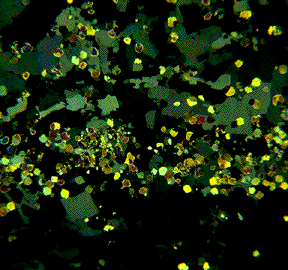
Here is the explanation I have settled on. Some readers,
and not just scientists, will be unforgiving about this unfair test of the
power of science to explain nature. But it is the best that can be done.
Each geologic basin has a history that moves from birth to life, and from
life to death, not unlike the compositions of Bach. The changes in climate
that were recorded in the Castile were no more than the sum of many annual
cycles of change. All cyclic processes are inherently variable and oscillate
like a musical composition.

Microscopic particles of calcite (yellow) frozen in place as they
settled on the floor of the deep Delaware Basin. The gray and black mosaic
is the light-colored layer (in polarized light).
When the Delaware Basin was young, as during a fugue's exposition, changes in climate had little effect on the particles of sediment that settled to the bottom of a new, deep basin. Oscillations induced by climate, began weakly, revealing the texture of the piece to follow. With maturity, the early subject of nature's fugue in the Castile, imposed by climate forces acting on a body of water of just the right size, became a counterpoint that was repeated, overlain, and amplified to sustain the beat and a richness of detail through a long struggle for chemical equilibrium. Having reached its peak of complexity and fullness, the filling of the basin ended in a grand coda, and finally, in death. Isn't this a fugue?